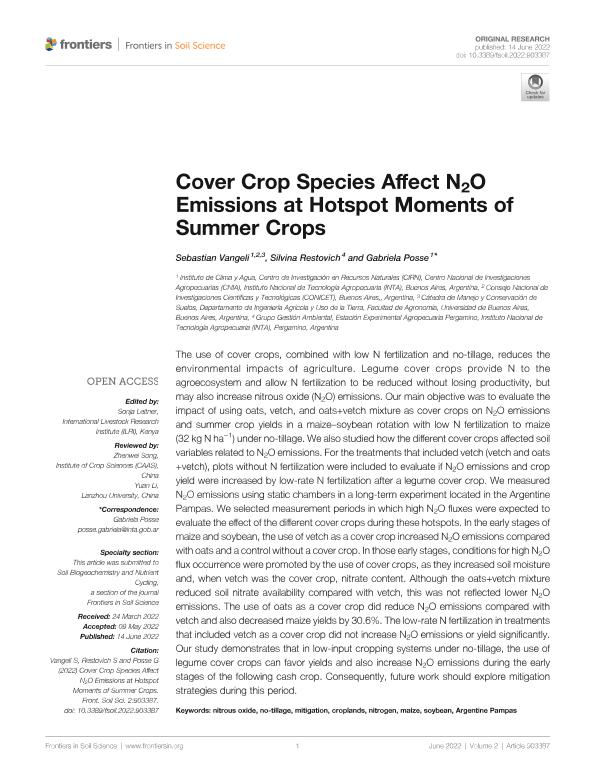Artículo
Cover Crop Species Affect N2O Emissions at Hotspot Moments of Summer Crops
Fecha de publicación:
06/2022
Editorial:
Frontiers Media
Revista:
Frontiers in Soil Science
ISSN:
2673-8619
Idioma:
Inglés
Tipo de recurso:
Artículo publicado
Clasificación temática:
Resumen
The use of cover crops, combined with low N fertilization and no-tillage, reduces the environmental impacts of agriculture. Legume cover crops provide N to the agroecosystem and allow N fertilization to be reduced without losing productivity, but may also increase nitrous oxide (N2O) emissions. Our main objective was to evaluate the impact of using oats, vetch, and oats+vetch mixture as cover crops on N2O emissions and summer crop yields in a maize–soybean rotation with low N fertilization to maize (32 kg N ha−1) under no-tillage. We also studied how the different cover crops affected soil variables related to N2O emissions. For the treatments that included vetch (vetch and oats+vetch), plots without N fertilization were included to evaluate if N2O emissions and crop yield were increased by low-rate N fertilization after a legume cover crop. We measured N2O emissions using static chambers in a long-term experiment located in the Argentine Pampas. We selected measurement periods in which high N2O fluxes were expected to evaluate the effect of the different cover crops during these hotspots. In the early stages of maize and soybean, the use of vetch as a cover crop increased N2O emissions compared with oats and a control without a cover crop. In those early stages, conditions for high N2O flux occurrence were promoted by the use of cover crops, as they increased soil moisture and, when vetch was the cover crop, nitrate content. Although the oats+vetch mixture reduced soil nitrate availability compared with vetch, this was not reflected lower N2O emissions. The use of oats as a cover crop did reduce N2O emissions compared with vetch and also decreased maize yields by 30.6%. The low-rate N fertilization in treatments that included vetch as a cover crop did not increase N2O emissions or yield significantly. Our study demonstrates that in low-input cropping systems under no-tillage, the use of legume cover crops can favor yields and also increase N2O emissions during the early stages of the following cash crop. Consequently, future work should explore mitigation strategies during this period.
Palabras clave:
NITROUS OXIDE
,
NO-TILLAGE
,
MITIGATION
,
CROPLANDS
Archivos asociados
Licencia
Identificadores
Colecciones
Articulos(SEDE CENTRAL)
Articulos de SEDE CENTRAL
Articulos de SEDE CENTRAL
Citación
Vangeli, Sebastián; Restovich, Silvina Beatriz; Posse Beaulieu, Gabriela; Cover Crop Species Affect N2O Emissions at Hotspot Moments of Summer Crops; Frontiers Media; Frontiers in Soil Science; 2; 6-2022; 1-11
Compartir
Altmétricas




